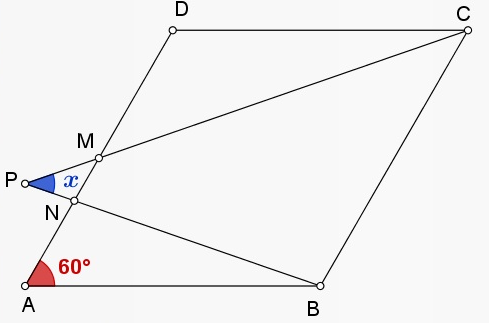A rhombus i

In rhombus , , is the mid-point of and point on is such that . The extensions of and intersect at and . Find .
The answer is 0.787.
This section requires Javascript.
You are seeing this because something didn't load right. We suggest you, (a) try
refreshing the page, (b) enabling javascript if it is disabled on your browser and,
finally, (c)
loading the
non-javascript version of this page
. We're sorry about the hassle.
Let the side length of rhombus A B C D be 1; then D M = 2 1 and N A = 3 1 . Let ∠ A B N = α and ∠ D C M = β . Draw a line through P parallel to A B and C D . We note that x = α + β . Let N Q be perpendicular to A B and M R be perpendicular to C D , then we have:
⎩ ⎪ ⎪ ⎪ ⎨ ⎪ ⎪ ⎪ ⎧ tan α = B Q N Q = 1 − N A cos 6 0 ∘ N A sin 6 0 ∘ = 1 − 3 1 × 2 1 3 1 × 2 3 = 5 3 tan β = C R M R = 1 + D M cos 6 0 ∘ D M sin 6 0 ∘ = 1 + 2 1 × 2 1 2 1 × 2 3 = 5 3 ⟹ α = β
Therefore, tan x = tan ( α + β ) = tan ( 2 α ) = 1 − tan 2 α 2 tan α = 1 − 2 5 3 2 × 5 3 = 1 1 5 3 ≈ 0 . 7 8 7 .